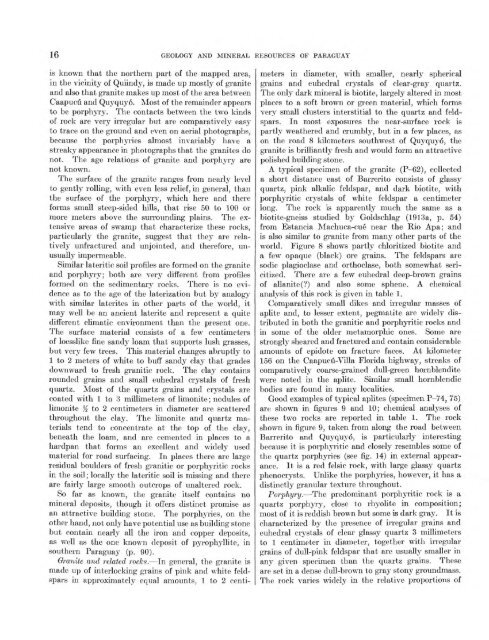Geology and Mineral Resources of Paraguay A Reconnaissance
Geology and Mineral Resources of Paraguay A Reconnaissance
Geology and Mineral Resources of Paraguay A Reconnaissance
- No tags were found...
You also want an ePaper? Increase the reach of your titles
YUMPU automatically turns print PDFs into web optimized ePapers that Google loves.
16 GEOLOGY AND MINERAL RESOURCES OF PARAGUAYis known that the northern part <strong>of</strong> the mapped area,in the vicinity <strong>of</strong> Quiindy, is made up mostly <strong>of</strong> granite<strong>and</strong> also that granite makes up most <strong>of</strong> the area betweenCaapucu <strong>and</strong> Quyquyo. Most <strong>of</strong> the remainder appearsto be porphyry. The contacts between the two kinds<strong>of</strong> rock are very irregular but are comparatively easyto trace on the ground <strong>and</strong> even on aerial photographs,because the porphyries almost invariably have astreaky appearance in photographs that the granites donot. The age relations <strong>of</strong> granite <strong>and</strong> porphyry arenot known.The surface <strong>of</strong> the granite ranges from nearly levelto gently rolling, with even less relief, in general, thanthe surface <strong>of</strong> the porphyry, which here <strong>and</strong> thereforms small steep-sided hills, that rise 50 to 100 ormore meters above the surrounding plains. The extensiveareas <strong>of</strong> swamp that characterize these rocks,particularly the granite, suggest that they are relativelyunfractured <strong>and</strong> unjointed, <strong>and</strong> therefore, unusuallyimpermeable.Similar lateritic soil pr<strong>of</strong>iles are formed on the granite<strong>and</strong> porphyry; both are very different from pr<strong>of</strong>ilesformed on the sedimentary rocks. There is no evidenceas to the age <strong>of</strong> the laterization but by analogywith similar laterites in other parts <strong>of</strong> the world, itmay well be an ancient laterite <strong>and</strong> represent a quitedifferent climatic environment than the present one.The surface material consists <strong>of</strong> a few centimeters<strong>of</strong> loesslike fine s<strong>and</strong>y loam that supports lush grasses,but very few trees. This material changes abruptly to1 to 2 meters <strong>of</strong> white to buff s<strong>and</strong>y clay that gradesdownward to fresh granitic rock. The clay containsrounded grains <strong>and</strong> small euhedral crystals <strong>of</strong> freshquartz. Most <strong>of</strong> the quartz grains <strong>and</strong> crystals arecoated with 1 to 3 millimeters <strong>of</strong> limonite; nodules <strong>of</strong>limonite % to 2 centimeters in diameter are scatteredthroughout the clay. The limonite <strong>and</strong> quartz materialstend to concentrate at the top <strong>of</strong> the clay,beneath the loam, <strong>and</strong> are cemented in places to ahardpan that forms an excellent <strong>and</strong> widely usedmaterial for road surfacing. In places there are largeresidual boulders <strong>of</strong> fresh granitic or porphyritic rocksin the soil; locally the lateritic soil is missing <strong>and</strong> thereare fairly large smooth outcrops <strong>of</strong> unaltered rock.So far as known, the granite itself contains nomineral deposits, though it <strong>of</strong>fers distinct promise asan attractive building stone. The porphyries, on theother h<strong>and</strong>, not only have potential use as building stonebut contain nearly all the iron <strong>and</strong> copper deposits,as well as the one known deposit <strong>of</strong> pyrophyllite, insouthern <strong>Paraguay</strong> (p. 90).Granite <strong>and</strong> related rocks. In general, the granite ismade up <strong>of</strong> interlocking grains <strong>of</strong> pink <strong>and</strong> white feldsparsin approximately equal amounts, 1 to 2 centimetersin diameter, with smaller, nearly sphericalgrains <strong>and</strong> euhedral crystals <strong>of</strong> clear-gray quartz.The only dark mineral is biotite, largely altered in mostplaces to a s<strong>of</strong>t brown or green material, which formsvery small clusters interstitial to the quartz <strong>and</strong> feldspars. In most exposures the near-surface rock ispartly weathered <strong>and</strong> crumbly, but in a few places, ason the road 8 kilometers southwest <strong>of</strong> Quyquyo", thegranite is brilliantly fresh <strong>and</strong> would form an attractivepolished building stone.A typical specimen <strong>of</strong> the granite (P-62), collecteda short distance east <strong>of</strong> Barrerito consists <strong>of</strong> glassyquartz, pink alkalic feldspar, <strong>and</strong> dark biotite, withporphyritic crystals <strong>of</strong> white feldspar a centimeterlong. The rock is apparently much the same as abiotite-gneiss studied by Goldschlag (1913a, p. 54)from Estancia Machuca-cue near the Rio Apa; <strong>and</strong>is also similar to granite from many other parts <strong>of</strong> theworld. Figure 8 shows partly chloritized biotite <strong>and</strong>a few opaque (black) ore grains. The feldspars aresodic plagioclase <strong>and</strong> orthoclase, both somewhat sericitized.There are a few euhedral deep-brown grains<strong>of</strong> allanite(?) <strong>and</strong> also some sphene. A chemicalanalysis <strong>of</strong> this rock is given in table 1.Comparatively small dikes <strong>and</strong> irregular masses <strong>of</strong>aplite <strong>and</strong>, to lesser extent, pegmatite are widely distributedin both the granitic <strong>and</strong> porphyritic rocks <strong>and</strong>in some <strong>of</strong> the older metamorphic ones. Some arestrongly sheared <strong>and</strong> fractured <strong>and</strong> contain considerableamounts <strong>of</strong> epidote on fracture faces. At kilometer156 on the Caapucu-Villa Florida highway, streaks <strong>of</strong>comparatively coarse-grained dull-green hornblenditewere noted in the aplite. Similar small hornblendicbodies are found in many localities.Good examples <strong>of</strong> typical aplites (specimen P 74, 75)are shown in figures 9 <strong>and</strong> 10; chemical analyses <strong>of</strong>these two rocks are reported in table 1. The rockshown in figure 9, taken from along the road betweenBarrerito <strong>and</strong> Quyquyo, is particularly interestingbecause it is porphyritic <strong>and</strong> closely resembles some <strong>of</strong>the quartz porplryries (see fig. 14) in external appearance. It is a red felsic rock, with large glassy quartzphenocrysts. Unlike the porphyries, however, it has adistinctly granular texture throughout.Porphyry. The predominant porphyritic rock is aquartz porphyry, close to rhyolite in composition;most <strong>of</strong> it is reddish brown but some is dark gray. It ischaracterized by the presence <strong>of</strong> irregular grains <strong>and</strong>euhedral crystals <strong>of</strong> clear glassy quartz 3 millimetersto 1 centimeter in diameter, together with irregulargrains <strong>of</strong> dull-pink feldspar that are usually smaller inany given specimen than the quartz grains. Theseare set in a dense dull-brown to gray stony groundmass.The rock varies widely in the relative proportions <strong>of</strong>
















